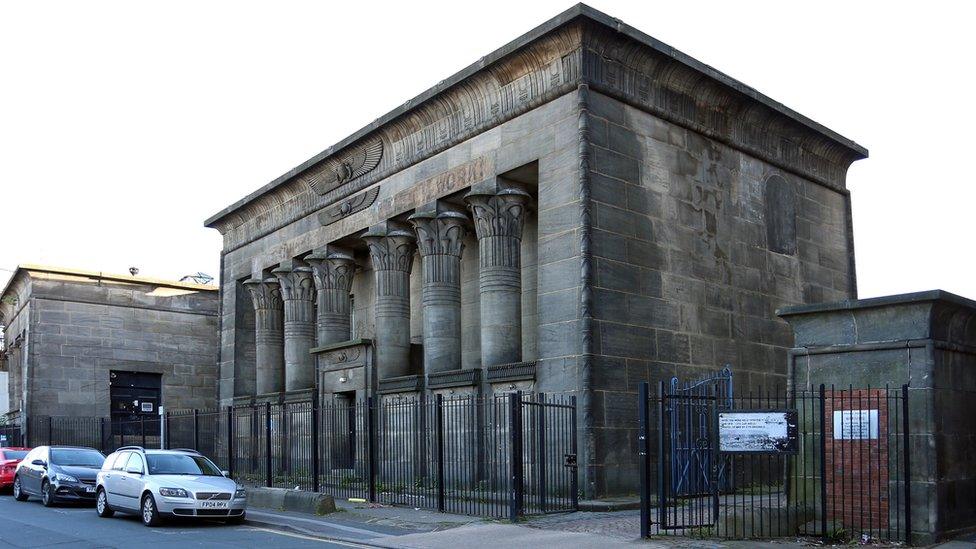Building a bigger home for the British Library collection
- Published
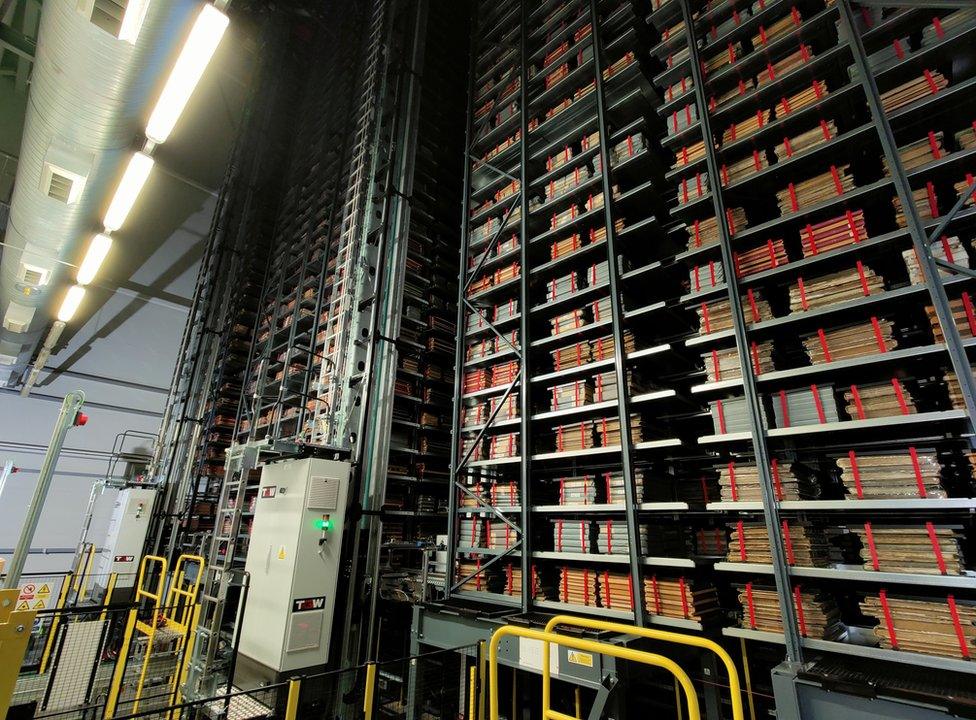
The National Newspaper Building holds the equivalent of 60 million issues and grows by 1,200 issues a week
The British Library's main storehouse is a marvel. An unrivalled collection of human knowledge with more than 300 miles of shelves tended by robot librarians. But as its stock of millions and millions of titles continues to swell, it desperately needs somewhere to put them. The BBC took a rare tour inside its cavernous vaults, and found out about plans to ensure the nation's printed works are preserved.
"We have finite space, but infinite amounts of material coming in."
Alasdair Bruce pithily summarises the big - and constantly growing - problem he and other bosses at the British Library face at its massive northern base in West Yorkshire.
From the outside, this repository which is intended to hold every book and publication published in the UK could not look less like a library.
Situated in Boston Spa, next to the football pitches of Leeds United's training ground and the barbed wire fences of a category C prison, the 44-acre facility is an architectural pick-and-mix of brutalist concrete, vast warehouses and even ex-World War Two munitions workshops.
Inside, though, three-quarters of the British Library's entire 170 million-strong collection can be found, including medical journals used by health workers researching Covid-19 treatments, electoral registers for families delving into their genealogy and decades-old newspapers used by police researching cold cases.
And, of course, books.
If something has come from a recognised UK publisher, it can either be found at the library's much more famous premises in central London, or here at its massive but somewhat non-descript Yorkshire base.
Each evening at the Boston Spa site, a lorry is loaded with books, newspapers and other tomes requested by members of the public at the library in London, with the titles arriving at its 11 reading rooms in St Pancras just 48 hours after order.
But, becoming home to seven million physical items in just the last 10 years, and requiring five miles of new shelving every year, the library's 550 staff at Boston Spa are currently fighting a losing battle against the constant wave of new publications - and the fear is that battle could be lost in a very short time.
Programme manager Mr Bruce says the library's site near Leeds, will be full to the brim in as little as two years.
A new solution is needed very soon.

A copy of The Globe newspaper from 1919, held at Boston Spa, warns about Russia and a fresh bout of Spanish Flu
That is why Mr Bruce is now part of the team leading plans for the site's biggest redevelopment in its 60-year history. While it is a battle against the clock, it is one he believes can be won.
"We have between two and three years before we are full in all our stores," he says.
"That is enough time for us to create a new building to cover our storage needs until mid-century."
The brimming bookshelves at Boston Spa are a direct result of what is known as the Legal Deposit Act.
That act means a copy of every work which has been published in the UK as far back as 1662 is placed in the British Library - with that rule expanded to include digital publications such as websites and blogs from 2013 onwards.
The act is in place to ensure the nation's published output is collected systematically and preserved for future generations to provide inspiration for future works.
But the downside to that laudable aim is the sheer physical space required to house the nation's source of knowledge and inspiration.
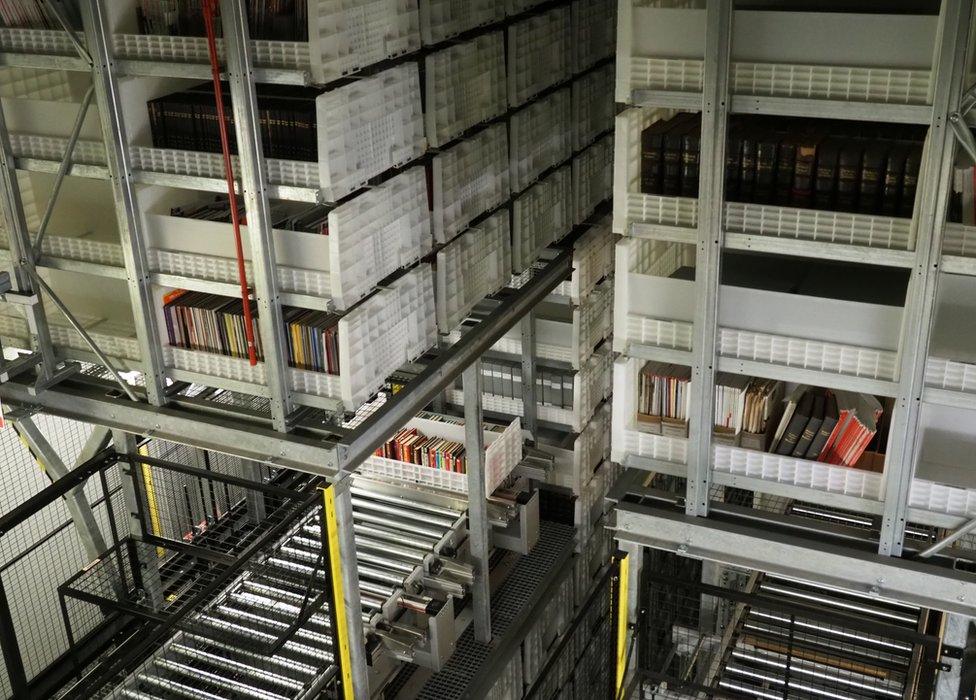
The Additional Storage Building at Boston Spa has space to house 11 million items, with up to 2,000 added each week
The current solution at Boston Spa is two cavernous storage buildings, each maintaining a constant temperature and humidity, with an oxygen level 7% lower than in the air outside their sealed doors.
"If you tried to strike a match in here, nothing would happen due to the lack of oxygen," Mr Bruce says.
Standing on a metal gantry inside what is known as the Additional Storage Building, he is interrupted by the whizzing of a giant robotic crane - one of seven which covers the length and height of the 272ft (83m) by 79ft (24m) warehouse, pulling out barcoded crates containing requested titles.
The nearby National Newspaper Building is just as impressive, with room for 60 million issues of local, regional and national UK newspapers from the last three centuries.
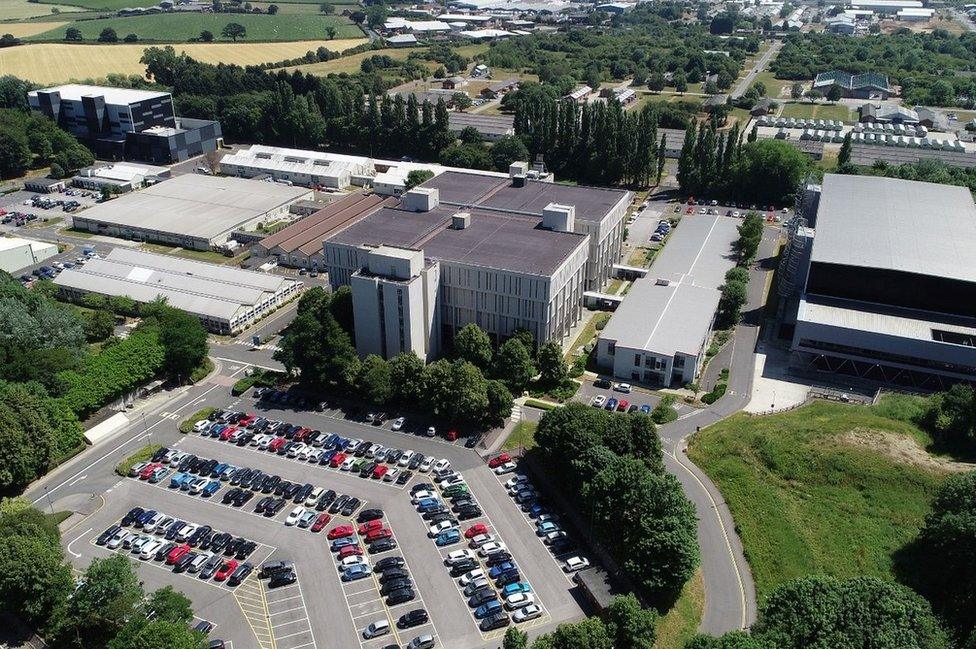
The British Library's site at Boston Spa was selected due to its central location and the ease of access
But with additions constantly being made to the library's shelves, a planned new storage building at the Boston Spa site, providing an extra 137 miles of shelf space, looks set to be coming at the perfect moment.
Mr Bruce says: "It's literally going to be just in time, but it is under control so I'm happy with that."
Phil Spence, the British Library's chief operating officer, says the new building would certainly be a much better solution than one he proposed 15 years ago.
"When I joined, I said, 'why don't we throw out some stuff which has less value?' I was very quickly shot down and told everything has value," he says.
"Something that might seem obscure to me, or might not be the next cancer treatment, still has value.
"It could be people interested in tortoises or whatever. It doesn't always have to create economic value, it can create fun, inspiration and joy."

British Library staff Phil Spence, Daniela Shedden and Alasdair Bruce are part of the team helping to redevelop the Boston Spa facility
The new storage building is part of a £95m redevelopment of the entire site, which will also introduce renewable energy sources in a bid to become carbon neutral and the welcome refurbishment of existing buildings used by staff.
Speaking in the library canteen, shortly before heading off to a cyber security training exercise which imagines hackers infiltrating the digital archives, Mr Spence says: "We're sitting in a 1940s bomb workshop. They're not particularly comfortable and our staff deserve more.
"We're the biggest employer in the culture sector outside of London, but they're currently working in the worst conditions."

British Library at Boston Spa - A potted history
1941: King George VI and Queen Elizabeth attend the opening of the Thorp Arch Royal Ordnance Munitions Factory
1962: Four years after munitions production ends, much of the site goes to house the newly-formed National Lending Library for Science and Technology
1973: The library departments of the British Museum, the National Central Library and the National Lending Library for Science and Technology come together to form the British Library
1975: The brutalist Urquhart Building becomes its first purpose-built structure
2001: The British Library Document Supply Centre hits the landmark of 100 million documents supplied
2009: The Additional Storage Building opens at the site, with the ability to hold 11 million books
2015: The National Newspaper Building opens, following the closure of the Newspaper Library at Colindale in London

With the new storage space, the British Library also hopes to respond to criticisms of its lack of accessibility in the north of England, with even some residents in West Yorkshire oblivious to the treasure trove on their doorstep.
The library has promised that the renovation work will rectify this, with a viewing gallery planned for the new storage unit, along with school visits, tours, a new reading room and a restaurant for visitors.
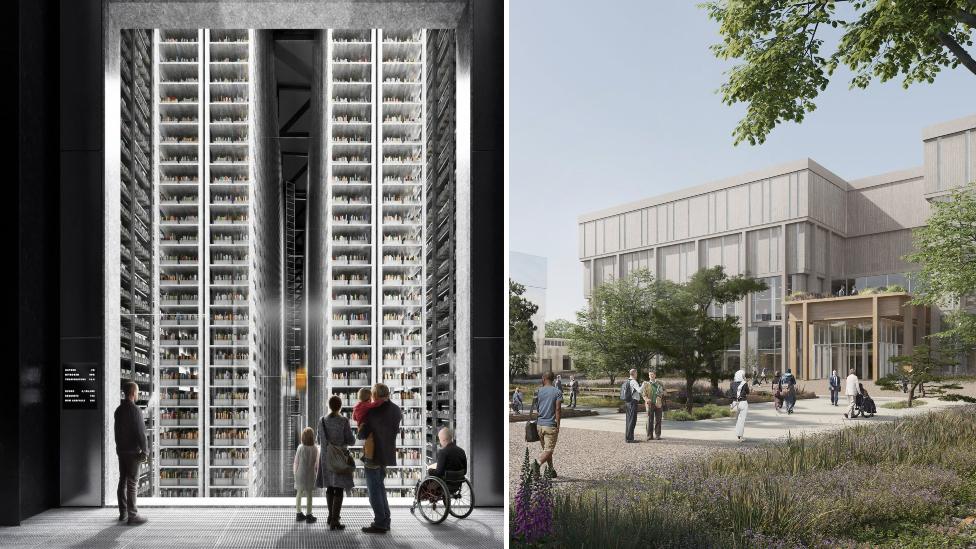
The renovation plans will include a public viewing area in the new storage unit to watch the robot librarians in action
A future ambition is to open a new British Library site at Leeds' landmark Temple Works building, turning the derelict mill into its public face in the North, with the scheme currently at the feasibility study stage.
While proudly admiring a huge model of the Boston Spa project, due for completion in 2026, Daniela Shedden, business change manager, says: "The vast majority of people don't even know we're here in Yorkshire.
"Yet, we've got so much to show here and we have bags of knowledge that you just don't get anywhere else.
"We want it to become an open space for everyone to come and visit."

Follow BBC Yorkshire on Facebook, external, Twitter, external and Instagram, external. Send your story ideas to yorkslincs.news@bbc.co.uk or send video here.
Related topics
- Published29 July 2021
